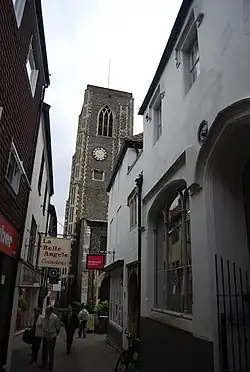Museum of Norwich at the Bridewell
The Museum of Norwich at the Bridewell (formerly The Bridewell and the Bridewell Museum)[1] is a museum of the social history of the city of Norwich in England. Constructed in the 14th century, it was one of the grandest medieval residences in the city.[1] Located next to St Andrew's Church, it is a Grade I listed building.[2] Over its history, it has operated as a residence, a house of correction, and a factory.
 Bridewell Alley in 2013, with Bridewell Museum on the right and St Andrew's Church in the distance | |
Former name |
|
|---|---|
| Location | Norwich, England |
| Coordinates | 52.6301°N 1.2954°E |
| Type | Social history museum |
| Curator |
|
| Website | museums.norfolk.gov.uk/museum-of-norwich |
Building
The original medieval building survives only in a fragmentary form, as an L-shaped range facing the alley by St Andrew's Church and constructed in three or more stages between the late 14th and early 15th centuries. It has two ranges of brick-vaulted undercrofts, which are the most extensive in Norwich.[1]
History
The building was the home of the Appleyard family during the 14th and 15th centuries, including Bartholomew Appleyard and his son William. Both were city bailiffs and William was the first mayor of Norwich and served as burgess in parliament ten times.[1] In 1584, the premises was purchased and converted into the city's house of correction, gaining its name as its Bridewell. In 1751, the Bridewell was badly damaged in a fire, damaging mostly its ground and first floor.[1] It was sold in 1828 following the construction of a prison at St Giles Gate, and the building then became a factory.[1] In 1923, it was purchased by Sir Henry Holmes, and donated to the city of Norwich.[1]
In the early 2010s, the museum underwent a major revamp costing £1.5 million. It was reopened in 2012 with 5,000 objects on display, including the last Jacquard loom to have woven cloth in Norwich, hats from Edwardian hat-maker Rumsey Wells, and a "history wall" mosaic created from over 9,000 photographs of Norwich that were submitted by the public.[3][4] Following the restoration of the sculpture of Samson that had stood at Samson and Hercules House in Tombland, Norwich, since 1657, the Museum began a crowdfunding campaign in 2018 to raise £15,000 to put the sculpture on display.[5] The campaign, nicknamed Saving Samson, was successful, and the sculpture was displayed at the museum in April 2019 inside a custom environmentally controlled glass case.[6][7]
See also
References
- King, Chris (15 October 2020). Houses and Society in Norwich, 1350-1660: Urban Buildings in an Age of Transition. Boydell & Brewer. doi:10.2307/j.ctv105bbb4. ISBN 978-1-78744-932-9. JSTOR j.ctv105bbb4. S2CID 241621345.
- "BRIDEWELL MUSEUM, Non Civil Parish - 1280532". Historic England. Archived from the original on 1 March 2023. Retrieved 10 September 2023.
- "Bridewell Museum to reopen after £1.5m revamp". BBC News. 29 June 2012. Archived from the original on 18 September 2023. Retrieved 10 September 2023.
- "City museum reopens to the public". BBC News. Archived from the original on 18 September 2023. Retrieved 10 September 2023.
- "Norwich nightclub's Samson statue: Funds appeal launched". BBC News. 14 February 2018. Archived from the original on 20 October 2021. Retrieved 11 September 2023.
- "Statue of Samson from Norwich nightspot back on display". BBC News. 3 April 2019. Archived from the original on 28 July 2019. Retrieved 11 September 2023.
- "Rotting 17th century wooden sculpture renovated by Norfolk Museums". The Art Newspaper - International art news and events. 7 June 2019. Archived from the original on 19 January 2022. Retrieved 11 September 2023.
External links
 Media related to Bridewell Museum, Norwich at Wikimedia Commons
Media related to Bridewell Museum, Norwich at Wikimedia Commons- Official website at Norfolk Museums